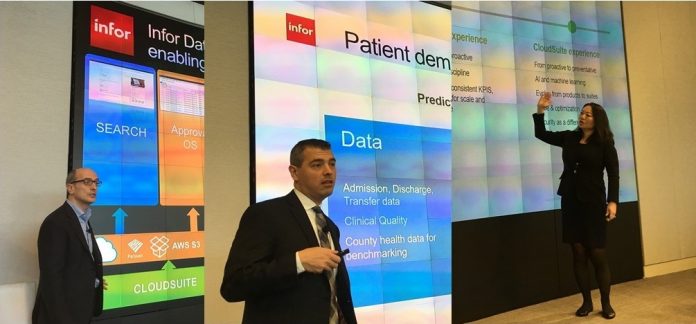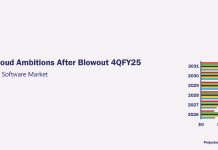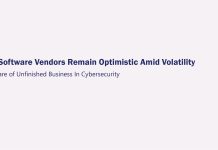
Infor, the $3-billion software vendor better known for its large collection of acquired ERP assets, is quickly capitalizing on the new fear factor that drives enterprise applications investment these days.
Enterprise customers big and small are grappling with the growing realization that what they are most afraid of is the fear of being left behind, rather than the oft-quoted fear of missing out. As a result, overcoming the fear of falling behind has become the impetus of many digital transformation initiatives.
Infor has gone through the same metamorphosis by boosting R&D spend in order to recast itself as the innovator, rather than just a serial acquirer that sniffs out every opportunity that comes its way. The reckoning of Infor is a far cry from its earlier mission when the 16-year-old company was controlled by a number of private equity firms whose primary concern was to milk every penny from its disparate ERP and enterprise applications by raising maintenance fees periodically or extending the collections of those recurring revenues with systematic upgrades and perhaps additional acquisitions.
That all changed in 2010 when Charles Phillips, a former Marine, stock analyst and Oracle president, became CEO of Infor as the twin effects of the financial crisis and Cloud conversion took a toll on the company’s ability to carry on with its holding company approach. Some of its 90,000 customers went under and the growing popularity of Cloud delivery made it difficult for Infor to continue charging hefty license and maintenance fees.
At one point, Infor went to IBM for help with Cloud support, essentially asking Big Blue to host its applications, which drew lackluster responses from its customers. In 2014, Infor started moving everything to Amazon Web Services to do the same. In fact, its customers can still ask Infor to host their current applications as a single tenant on AWS even though its CloudSuite is increasingly being delivered as multi-tenant instances.
Meanwhile, Infor continued to sell its onpremise software licenses, albeit under different circumstances because of stiff competition from a growing array of onprem and Cloud rivals like Constellation Software and HotSchedules that are also sharpening their microvertical capabilities, something that Infor has been perfecting for years in segments like equipment rental operators and microbreweries.
Koch And Other Empires Strike Back
Infor’s turning point surfaced in 2017 when it secured a $2-billion+ investment from Koch Industries, one of the largest privately-held companies in the United States with more than 160,000 employees and $115 billion in revenues selling everything from oil pipeline services to fertilizers to paper towels.
After buying out the majority stake in Infor from its PE owners including Golden Gate Capital and Summit Partners, Koch started pumping money into Infor not only as an investor, but also as a customer under a five-year Cloud deal worth $43 million.
Flint Hills Resources, a refining, chemicals and biofuels division of Koch Industries with 4,000 employees and $23 billion in revenues, went live in March 2018 with Infor Cloud Financials after a 10-month evaluation and implementation. By replacing Oracle Financials, a 20-year-old legacy system that proved to be too costly and complex because of heavy modifications, Flint Hills Resources expects the Infor Cloud applications to address its needs – 350,000 journal entries monthly and up to 10,000 invoices being processed daily – with ease and at enterprise scale.
The Cloud first and mobile-centric product strategy from Infor will allow Flint Hills Resources to take advantage of constantly improving best practices, according to company executives.
What the ties that bind Infor and Koch suggest that they would be in this digital transformation journey together for the long haul. Unlike PE-owned software vendors whose fate may get upended every few years as their owners offload them to another PE firm after pocketing some dividends, the Koch empire considers the Infor acquisition, the largest tech deal in its history, pivotal because it’s part of the family. “By working closer with Infor, we can anticipate change within our own business,” said Steve Feilmeier, CFO of Koch Industries during Infor’s Inforum user conference in July 2017.
Not only Infor needs to succeed on its own merit, but also it will have to look good for Koch and its business partners. Flint Hills Resources, for one, does business with 30,000 vendors and 6,000 customers. If Infor Financials delivers positive results to Flint Hills Resources, it’s conceivable that some of its vendors and customers could do well by adopting Infor.
As a result, buying Infor does represent a rebuke of any tech vendor that wants to barge into Koch’s sphere of influence by winning over its own business partners and customers.
Koch is not the only one readying to strike back. Turtle & Hughes, a 95-year-old distributor of electrical and industrial supplies in Linden, N.J., adopted a range of Infor applications for CRM, ERP(SX.e) and supplier exchange in order to accelerate its move to become an omni-channel distribution company, while staving off increased competition from both online and offline rivals.
When asked how much investment Turtle & Hughes is willing to make in order to score points in its digital transformation initiative, Ajay Kamble, CIO of Turtle and Hughes, said the decision to remake his company rests with a simple premise of “do or die.’’ With the advent of electronic commerce, coupled with an increasingly fickle clientele that demands real-time information and digital transactions, it is becoming an imperative for enterprises like Turtle & Hughes to align themselves with someone like Infor to pursue digital transformation initiatives deemed strategic to their survival.
By taking these initiatives into their own hands, these enterprises are reasserting that they are in full control of their own destiny. Any private utter or public display of the trepidation is at the heart of this neurosis turning into quiet determination, which morphs into preemptive strike.
What they all have in common is to use the latest technologies to strike back at their opponents, winning the perception battle as they regain the upper hand to set the agenda for the next few decades regardless of where and how market shifts will land them.
Infor Innovation Is Loaded and Ready
That’s why the Infor innovation campaign is critical. During a recent gathering of customers and industry analysts at its New York headquarters in the shadow of the Empire State Building, Infor aims to position itself as the innovation-driven software powerhouse by trumpeting advances in artificial intelligence under the Coleman umbrella, deep-learning analytics based on its recent acquisition of Birst, strategic relationships with Cloud partners like AWS, not to mention its years of experience of selling into strategic verticals like manufacturing, healthcare, and public sector.
Without much fanfare, Infor has been quietly ramping up its R&D spend to develop solutions that help solve many daunting challenges facing industrials and asset-intensive companies from oil and gas giants to some of the world’s biggest transit organizations that rely on its applications for rapid financial closing and repair tracking.
In 2008, Infor, which operated more like a holding company with different product silos mostly through acquisitions, spent 11% of its revenues on R&D. Today, that figure is projected to jump to 16% in its current fiscal year, nearly doubling the actual spend to about $500 million as shown in the following table.

The two-day event in March 2018 showcased Infor’s quest to become an innovation-driven company, where the money is headed and the expected returns for its 90,000 customers. The event is a manifestation of the enterprise software empire fighting back to become the vendor of choice fit for any company wanting to transform itself in the digital age. No longer are these companies satisfied with green-screen terminals(still being used among some Infor’s AS/400 installations), Infor is heeding their calls by crafting a coherent product portfolio that is capable of meeting their explosive data and reporting needs in the long run with a visually attractive and intuitive consumer-grade experience.
Infor’s holistic approach comes after years of acquiring and combining brands like Extensity for travel and expense management, Baan/BPCS/Geac/Mapics/SSA/Systems Union for ERP maintenance business, Lawson and PeopleAnswers for HCM, Intentia for manufacturing ERP, GT Nexus for supply chain, Predictix and Starmount for retail, and most recently Birst for Business Intelligence.
The focal point of this preemptive strike is Infor OS, an all-encompassing platform that supports the data management repository for readily available enterprise insights grouped under Infor Data Lake, actionable recommendations packaged as Infor Reveal as well as an assortment of shared services like Coleman for AI, EAM for enterprise asset management particularly in Internet of Things(IoT) deployment and Birst for full-stack analytics and automated data refinement.
Massimo Capoccia, Infor’s Senior Vice President of Infor OS, said with more than 7,000 customers already running Infor OS for a number of years, the platform is scaling out to reach additional accounts in Europe and Asia with dedicated services and support resources, along with data center facilities that tune to their needs.
One possible scenario is that the flu epidemic that has caused havoc in many countries could be better managed by healthcare providers when running the Infor CloudSuite based on Infor OS along with a host of analytics tools including Infor Reveal that could be instrumental in helping care givers do a better job when responding to and addressing patient inflows, medical supply issues and staffing levels.
In response to the diverse needs of its 90,000 customers, Infor is expected to be creating hundreds of these cross-domain insights and recommendations designed for general-purpose improvements like lead scoring or cash flow what-if scenarios and industry-specific requirements like raw materials optimization or quality management for mixed-mode manufacturing, said Ziad Nejmeldeen, senior vice president and chief scientist of Infor.
Currently about 10% of its installed base has moved to the Cloud and it may take years before the remainder migrates their existing systems to Infor CloudSuite or one of these Infor Reveal insights. But there are enough examples to suggest that the accelerating move toward a modern system landscape is irreversible.
For instance, the New York Metropolitan Transportation Authority has been working toward that goal by standardizing its enterprise asset management function with the use of Infor EAM. Once it goes live system-wide, thousands of users at MTA will be accessing Infor EAM to help track, monitor and optimize $1 trillion in assets, while realizing the full benefits of a Cloud-based, mobility-centric EAM solution. The transformation of MTA is a microcosm of what the Empire State is doing with its aging infrastructure.
Under CEO Phillips, a former stock analyst at Morgan Stanley who moved Infor’s headquarters from Atlanta to New York in 2012, Infor has made New York the centerpiece of its image-remaking campaign as well. Steering clear of typical convention sites in Las Vegas and Orlando, Infor has hosted its major user conference Inforum in New York since 2016, bringing in thousands of customers and partners. At Inforum, the vendor has been trotting out local customers like MTA as references running its latest products and colleges like CUNY, Fashion Institute of Technology and Queens College as part of its education alliance program to ensure a healthy pipeline for next-generation software architects, programmers and data scientists.
Over the past decade, New York has also been transforming itself by making Big Apple more user-friendly with heavy investments both in terms of quality of life as well as its infrastructure. That covers everything stretching from the West Side with the pedestrian-friendly High Line and the $20-billion Hudson Yards as the new premier address of corporate America to the East with the hip neighborhoods in the Brooklyn borough, which now lays claim to a young and aggressive pro-basketball team Brooklyn Nets. Infor has its hands on almost all of the above either as the software provider or corporate sponsor.
Turning Fear Into Power
Juxtapositioning the comeback story of Infor against New York’s own changes has some parallels. Invariably, renovating an aging system comes with a high price tag.
In its latest 10Q, Infor announced a 36% jump in Cloud subscription revenues to $138 million on a 10% rise in total revenues of $777 million. Despite the improved Cloud business for the quarter, Infor also posted a $46 million in impairment charges for certain Infor CloudSuite Retail offerings that turned out to be less profitable than previously expected. The disclosure underscores Infor’s challenges of reviving an extensive product portfolio and the result is sometimes hit or miss.
Similarly, its heavy reliance on AWS comes at a time when customer experience in the Cloud is more demanding than ever. While it might have to disappoint some customers if AWS fails to deliver reliable Cloud services on a global level, Infor is also investing heavily in its Cloud operations to layer personalized services on top of AWS to optimize Cloud user experiences.
Senior Vice President of Infor Cloud Operations Mayumi Hiramatsu said the priorities lie in strengthening the security aspects for its Cloud customers, while improving easy access to automated services like Cloud Suite Portal for self-service capability and greater emphasis on Dev Ops for standardization on KPIs, processes and tools. In other words, managing surprises better helps mitigate the risks of actual surprises during any downtime or service disruption.
As Infor places its bets on many products and different initiatives, it’s inevitable that it would run into such surprises. Similar to the trials and errors faced by its customers, one has to give credit to the rejuvenated Infor for having no fear of making mistakes. In doing so, it is admirable that Infor might be the first to head off any trouble on behalf of its customers as many of them are also aiming to turn fear into power.





